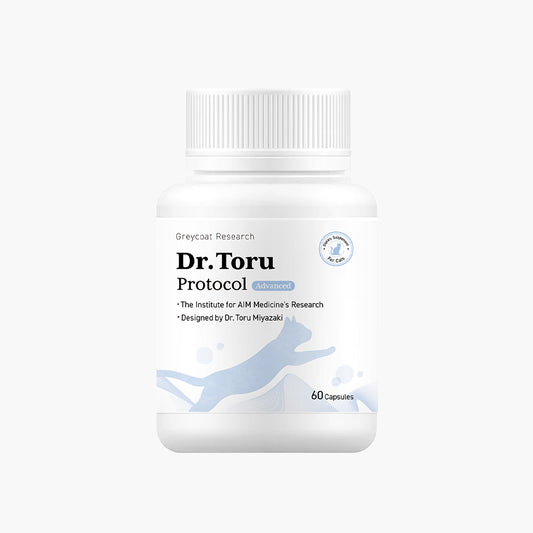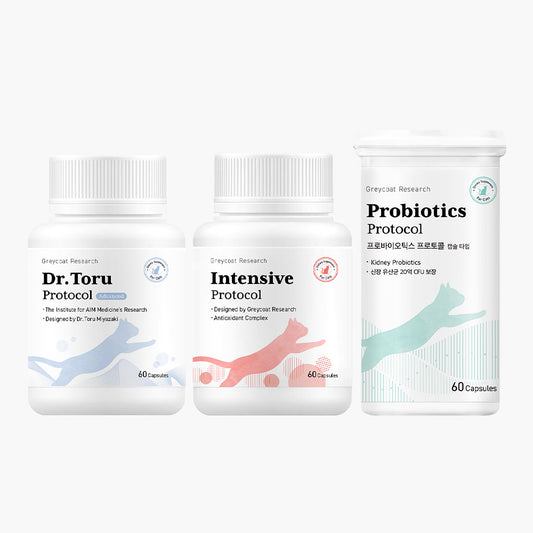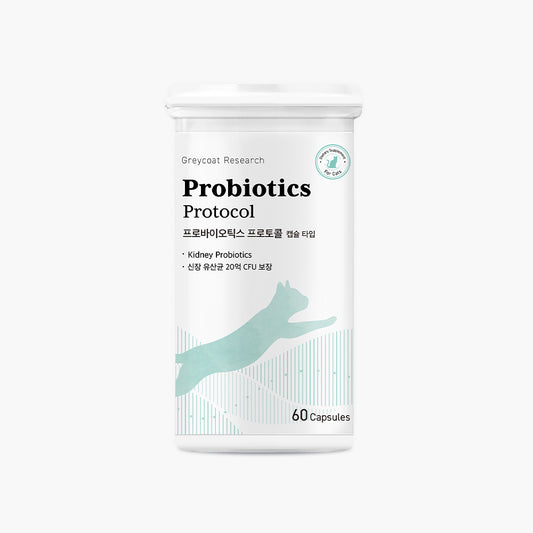
A cat playing with a toy.
1. Dopamine: The Most Commonly Overlooked Factor in Cat Care
Do you pamper your cat, giving them all the treats you think they deserve as you admire their cuteness? This could actually be bad for a cat's kidneys.
Cats release dopamine through activities like hunting, exploring new environments, and engaging in various activities. However, if they sit around all day without getting the exercise they need, their dopamine levels may not be released properly, which can negatively impact their kidney health.

A cat lying around doing nothing.
If your cat has kidney disease, remember this: Letting your cat rest all day long can actually make their kidney disease even worse. Just 10 minutes of play and new experiences can make a world of difference in your cat’s health.
Greycoat Research provides personalized 1:1 consultations for cats with kidney disease based on data collected from over 1,000 consultation cases.
2. The Connection Between Dopamine and Kidney Health
When a cat engages in interesting activities or explores a new environment, dopamine is released in their brain. But contrary to popular belief, dopamine isn’t just a hormone that makes them feel good—it does much more.
How Does Dopamine Affect the Kidneys?
- Increases blood flow to the kidneys
- Regulates mineral balance in the body
- Activates kidney function
Just as supplements for cats with kidney disease are designed based on the principle of increasing blood flow to the kidneys, natural dopamine release also plays a crucial role in boosting kidney blood flow. In fact, studies on the relationship between dopamine and kidney health have shown that dopamine plays a positive role in increasing kidney blood flow and regulating kidney function.
3. The Case of General: Staying Strong Against Stage 4 CKD with Dopamine
The story of General, a cat with stage 4 chronic kidney disease (CKD) managed by Greycoat Research, is a prime example of how activity levels and environmental changes can directly impact kidney health.

General enjoying a walk in the garden.
Changes in General’s Life
- Before – Enjoyed daily 10 minute walks in the garden and chased after bugs
- After – Moved to a house with no garden, with reduced opportunities for new experiences and activities
As a result of his decreased activity, General’s kidney function deteriorated rapidly.
Previously, General had the opportunity to increase kidney blood flow by exploring the garden for 10 minutes a day, but with the shift to indoor living, dopamine production decreased, and his condition gradually worsened.
Since witnessing the deterioration of General’s condition, Greycoat Research has actively recommended that cat owners provide their cats with at least 10 minutes of playtime (like play hunting) and new experiences/activities every day.
4. 4 Ways to Trigger Dopamine Release in Cats with Kidney Disease
Even cats with kidney disease can release dopamine as long as the proper methods are used. However, as excessive excitement can put a strain on their kidneys, activities should be limited to 10 minutes a day.
Provide Safe Outdoor Environments
A short walk in a fenced garden or a controlled outdoor space, where your cat can sniff new smells, can be helpful. Chasing bugs or exploring while taking in fresh air can stimulate dopamine production.

A cat exploring a garden.
Play Hunting (with Toys)
While chasing after live bugs is the most effective way for cats to release dopamine, this may not be feasible depending on your living conditions. In such occasions, toys can serve as acceptable substitutes.
Regularly changing the types of toys can keep things fresh for your cat, and mimic the experience of exploring new environments.

A cat hunting a toy.
Outdoors Exploration with Carrier (Depending on Cat)
For cats that are not stressed by outings, allowing them to enjoy the breeze in a spacious carrier is a good option.
Let them experience a new environment safely in the carrier in a quiet area near your home.

A cat experiencing a new environment from a carrier.
Change in Indoor Environment
Simply changing the position of the cat tower or rearranging the hiding spots can stimulate dopamine release. Environmental changes can create small amounts of tension and anticipation, which can have a positive impact on kidney health.

A cat exploring a new addition to the house.
5. Just 10 Minutes of Dopamine Management Can Change a Cat’s Kidneys
Simply keeping your cats at home, safe and cherished, is not always the best choice for them. In fact, cats with kidney disease are actually more in need of just 10 minutes of dopamine a day to maintain their health.
- Even 10 minutes of play and environment changes can make a huge difference!
- Increased blood flow to the kidneys can help maintain kidney functions!
- Don’t overdo it! 10 minutes a day of short stimulations is the most effective approach!
Greycoat Research provides personalized 1:1 consultations for cats with CKD, based on data collected from over 1,000 consultation cases.
If you’re having difficulties managing your cat’s kidney disease, contact Greycoat Research for a free consultation today.




